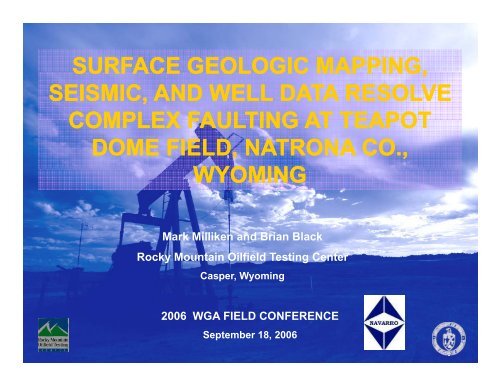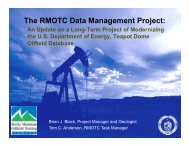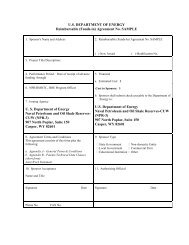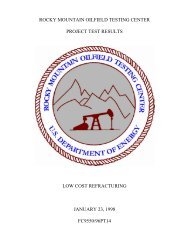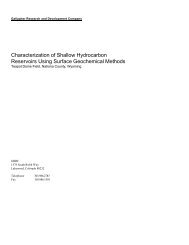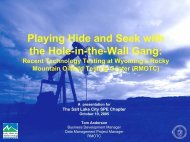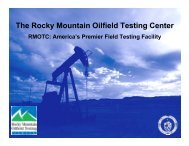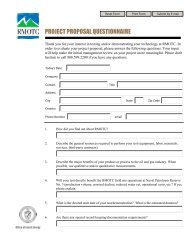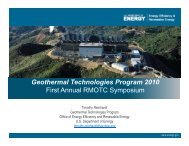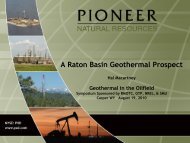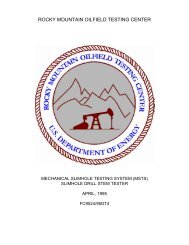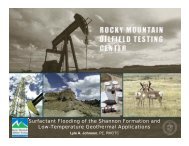Teapot Dome faulting - RMOTC
Teapot Dome faulting - RMOTC
Teapot Dome faulting - RMOTC
Create successful ePaper yourself
Turn your PDF publications into a flip-book with our unique Google optimized e-Paper software.
SURFACE GEOLOGIC MAPPING,<br />
SEISMIC, AND WELL DATA RESOLVE<br />
COMPLEX FAULTING AT TEAPOT<br />
DOME FIELD, NATRONA CO.,<br />
WYOMING<br />
Mark Milliken and Brian Black<br />
Rocky Mountain Oilfield Testing Center<br />
Casper, Wyoming<br />
2006 WGA FIELD CONFERENCE<br />
September 18, 2006
2<br />
Organization<br />
• Introduction<br />
• Purpose and goals of study<br />
• Past work<br />
• Stratigraphy and seismic character<br />
• Surface mapping<br />
• Subsurface mapping and fault interpretation<br />
• Production potential<br />
• Further research opportunities
3<br />
NPR-3<br />
Location<br />
NPR-3<br />
Structural interpretation<br />
courtesy of Tim McCutcheon
4<br />
Cumulative<br />
Production<br />
Salt Creek<br />
670 MMBBLS<br />
722 BCF<br />
<strong>Teapot</strong> <strong>Dome</strong><br />
27 MMBBLS<br />
57 BCF
5<br />
NPR3 PRODUCTION<br />
TENSLEEP<br />
9%<br />
MUDDY<br />
2%<br />
3WC<br />
2%<br />
DAKOTA<br />
1%<br />
2WC<br />
12%<br />
SHANNON<br />
50%<br />
SHALE<br />
24%
6<br />
• Introduction<br />
• Purpose and goals of study<br />
• Past work<br />
• Stratigraphy and seismic character<br />
• Surface mapping<br />
• Subsurface mapping and fault interpretation<br />
• Production potential<br />
• Further research opportunities
7<br />
Purpose and Goals of Study<br />
• Tie surface geology to subsurface using old<br />
fashioned field work and cutting edge workstation<br />
technology.<br />
• Determine individual fault block geometries and<br />
fault sealing character.<br />
• Identify new primary potential production from<br />
undrained d fracture systems and fault blocks.
8<br />
• Introduction<br />
• Purpose and goals of study<br />
• Past work<br />
• Stratigraphy and seismic character<br />
• Surface mapping and fault interpretation<br />
• Subsurface mapping<br />
• Production potential<br />
• Further research opportunities
McCutcheon, 2003<br />
10
11<br />
• Introduction<br />
• Purpose and goals of study<br />
• Past work<br />
• Stratigraphy and seismic character<br />
• Surface mapping<br />
• Subsurface mapping and fault interpretation<br />
• Production potential<br />
• Further research opportunities
13<br />
NPR-3 STRUCTURE<br />
DIP SECTION
NPR-3 Dip Section<br />
14<br />
WEST<br />
EAST
15<br />
NPR-3 STRUCTURE<br />
STRIKE SECTION
16<br />
NPR-3 Strike Section<br />
NORTHWEST<br />
SOUTHEAST<br />
Frontier<br />
Dakota<br />
Tensleep<br />
Basement
17<br />
• Introduction<br />
• Purpose and goals of study<br />
• Past work<br />
• Stratigraphy and seismic character<br />
• Surface mapping<br />
• Subsurface mapping and fault interpretation<br />
• Production potential<br />
• Further research opportunities
UPPER<br />
CRETACEOUS<br />
STEELE SHALE<br />
FORMATION<br />
18<br />
Shannon<br />
A and B<br />
Sandstones
19<br />
Sussex<br />
Sandstone
20<br />
Sussex<br />
Bentonites
21<br />
160<br />
V9<br />
Well 68-S-27<br />
140<br />
V8<br />
120<br />
V7<br />
Feet abov ve base of<br />
section<br />
100<br />
80<br />
60<br />
40<br />
V6<br />
V5<br />
V4<br />
V3<br />
V2<br />
Suss sex Bento onites<br />
20<br />
V1<br />
0<br />
Correlations of measured section to well log
22<br />
Outcrop Character<br />
V1<br />
Bentonite<br />
Sussex<br />
Sandstone
23<br />
Outcrop Character<br />
Sussex Bentonites<br />
V2<br />
V3-V9
24<br />
Outcrop Character<br />
Sussex Bentonites
25<br />
Quaternary terrace<br />
V5<br />
V4<br />
V3
26<br />
Surface<br />
Faulting at<br />
NPR-3<br />
V2<br />
outcrops<br />
Sussex V2 Bentonite
27<br />
V3-9<br />
SOUTH<br />
V1<br />
V2
28<br />
About 15 ft of<br />
Sussex Sandstone<br />
dip-slip displacement<br />
U<br />
D
31<br />
Trench
33<br />
Surface<br />
Faulting at<br />
NPR-3
Research by Brennan and others, 2006, USGS OFR 2006-1214<br />
34
35<br />
Section 10<br />
normal<br />
<strong>faulting</strong>
36<br />
U<br />
D<br />
V1 Bentonite<br />
Sussex Sandstone
37<br />
Section 10 Fault<br />
V1 Bentonite<br />
About 25 feet of dip-<br />
slip displacement<br />
Sussex<br />
Sandstone
38<br />
• Introduction<br />
• Purpose and goals of study<br />
• Past work<br />
• Stratigraphy and seismic character<br />
• Surface mapping<br />
• Subsurface mapping and fault interpretation<br />
• Production potential<br />
• Further research opportunities
Combining Cutting Edge Technology with Old<br />
Fashioned Geological Interpretation<br />
39
40<br />
Subsurface<br />
<strong>faulting</strong> in<br />
Shannon<br />
sandstone
3D Surface on Top of Shannon SS<br />
41
Subsurface <strong>faulting</strong> in Shannon sandstone<br />
42
Surface and Subsurface Fault Traces<br />
43<br />
Surface fault traces
44<br />
Faulting<br />
in 3D<br />
Seismic<br />
i<br />
Data
45<br />
Faulting<br />
in 3D<br />
Seismic<br />
Data
46<br />
Time slice at<br />
1100 ms<br />
showing<br />
deep faults<br />
(approx 5000<br />
(approx 5000<br />
feet below<br />
surface)
Faulting Interpretation in Seismic Data<br />
47
Faulting Interpretation in Seismic Data<br />
48
50<br />
High<br />
Resolution<br />
Shallow<br />
2D<br />
Seismic<br />
Acquisition
51<br />
LINE 1<br />
Seismic images provided by John McBride- Brigham Young University
LINE 2<br />
52<br />
Seismic images provided by John McBride- Brigham Young University
Comparison of 3D vs High-Res Shallow 2D Seismic<br />
53<br />
LINE 2
54<br />
• Introduction<br />
• Purpose and goals of study<br />
• Past work<br />
• Stratigraphy and seismic character<br />
• Surface mapping<br />
• Subsurface mapping and fault interpretation<br />
• Production potential<br />
• Further research opportunities
55<br />
Production from<br />
calcified fault<br />
fault zone
48-2-X-28 Blow-out<br />
High pressure in fault/fracture zone within Niobrara Shale<br />
56<br />
Well #48-X-2-28<br />
Horizontal Tract<br />
Surface Trace<br />
Sub-surface Trace
57<br />
• Introduction<br />
• Purpose and goals of study<br />
• Past work<br />
• Stratigraphy and seismic character<br />
• Surface mapping<br />
• Subsurface mapping and fault interpretation<br />
• Production potential<br />
• Further research opportunities
58<br />
Ground-truthing of subsurface faults,<br />
tying surface faults to well data
59<br />
Mapping of faults<br />
projected along<br />
trend into the<br />
Parkman<br />
Sandstone, Mesa<br />
Verde Formation
60<br />
3D Seismic Interpretation<br />
• Structure Mapping in deeper horizons<br />
Integration of well control<br />
Time to Depth Conversion<br />
• Fault Characterization and Mapping<br />
Detailed mapping at reservoir scale<br />
Determine vertical separation<br />
Seals vs leaks<br />
• Reservoir Characterization<br />
Seismic modeling and reservoir mapping
Questions?<br />
61


